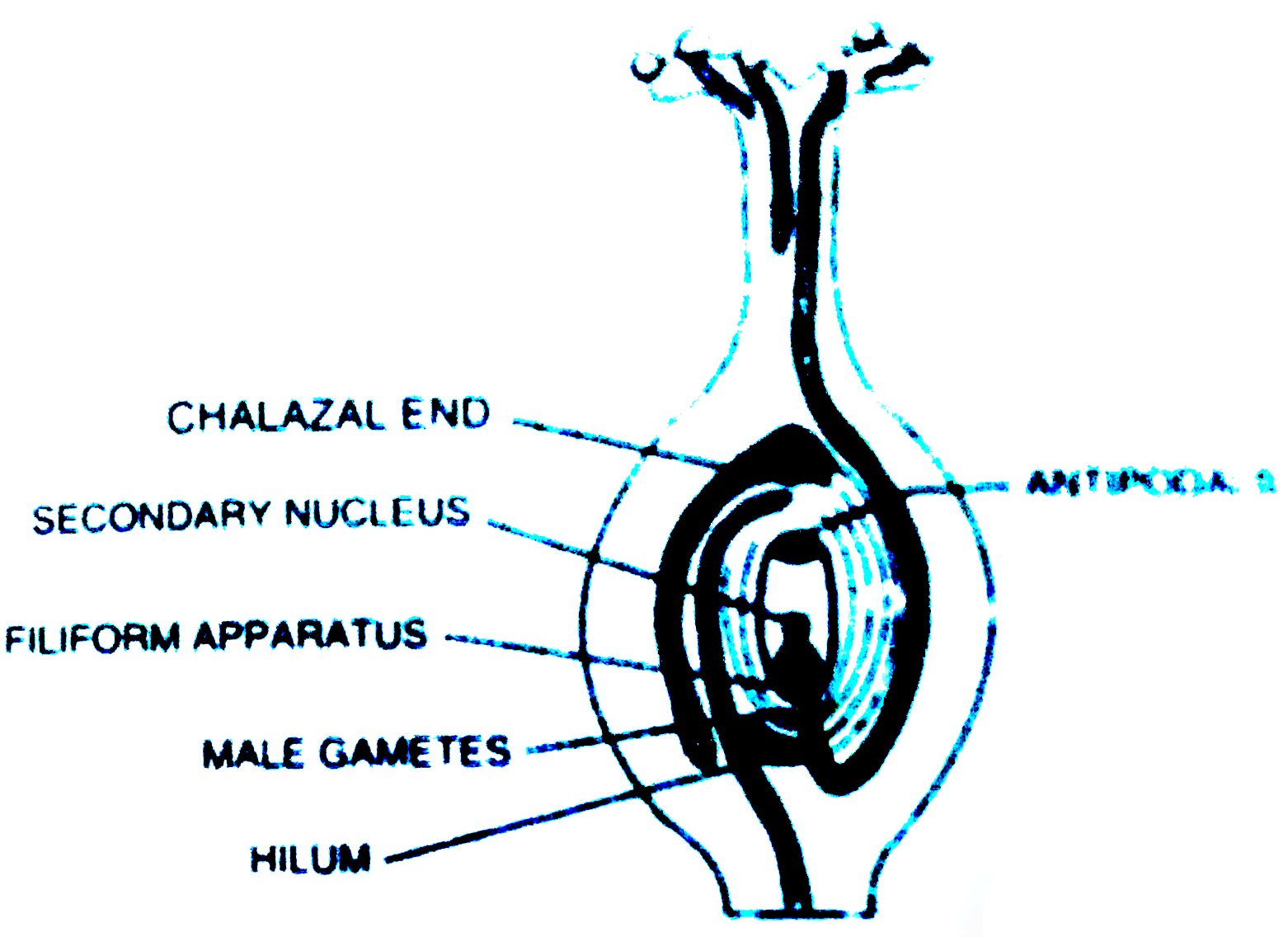In double fertilization, male gamete and secondary nucleus form
Endosperm
Gamete
Embryo
Egg.
The correct Answer is:A
Step-by-Step Solution
1. Understanding Double Fertilization:
- Double fertilization is a unique process that occurs in angiosperms (flowering plants). It involves two fertilization events within the ovule.
2. Structure of the Ovule:
- The ovule consists of several key components:
- Antipodal Cells: Located at the chalazal end, typically three in number.
- Synergids: Found at the micropilar end, usually two in number, which help guide the pollen tube.
- Egg Cell: Located between the synergids, which is the female gamete.
- Central Nuclei (Polar Nuclei): Two nuclei located centrally within the ovule.
3. Pollen Grain Arrival:
- When pollen grains arrive at the ovule, one pollen grain will fertilize the egg cell, resulting in the formation of the zygote (the first fertilization event).
4. Formation of the Primary Endosperm Nucleus:
- The second pollen grain travels to the central nuclei (polar nuclei) and fuses with them. Since there are two polar nuclei (2n) and one pollen grain (n), the fusion results in a triploid nucleus (3n), known as the primary endosperm nucleus (PEN).
5. End Result:
- The two fertilization events lead to the formation of:
- A diploid zygote from the fusion of the male gamete and the egg cell.
- A triploid primary endosperm nucleus that will develop into the endosperm, providing nourishment to the developing embryo.
Final Answer
In double fertilization, the male gamete fuses with the egg cell to form a zygote, while another male gamete fuses with the two polar nuclei to form the primary endosperm nucleus (PEN), which will develop into the endosperm.
---
- Double fertilization is a unique process that occurs in angiosperms (flowering plants). It involves two fertilization events within the ovule.
- The ovule consists of several key components:
- Antipodal Cells: Located at the chalazal end, typically three in number.
- Synergids: Found at the micropilar end, usually two in number, which help guide the pollen tube.
- Egg Cell: Located between the synergids, which is the female gamete.
- Central Nuclei (Polar Nuclei): Two nuclei located centrally within the ovule.
- When pollen grains arrive at the ovule, one pollen grain will fertilize the egg cell, resulting in the formation of the zygote (the first fertilization event).
- The second pollen grain travels to the central nuclei (polar nuclei) and fuses with them. Since there are two polar nuclei (2n) and one pollen grain (n), the fusion results in a triploid nucleus (3n), known as the primary endosperm nucleus (PEN).
- The two fertilization events lead to the formation of:
- A diploid zygote from the fusion of the male gamete and the egg cell.
- A triploid primary endosperm nucleus that will develop into the endosperm, providing nourishment to the developing embryo.
In double fertilization, the male gamete fuses with the egg cell to form a zygote, while another male gamete fuses with the two polar nuclei to form the primary endosperm nucleus (PEN), which will develop into the endosperm.
Topper's Solved these Questions
- BOOK - DINESH PUBLICATION ENGLISHCHAPTER - NO IDEAEXERCISE - Check Your Grasp32videos
NO IDEA
- BOOK - DINESH PUBLICATION ENGLISHCHAPTER - NO IDEAEXERCISE - Brain Teasers37videos
NO IDEA
- BOOK - DINESH PUBLICATION ENGLISHCHAPTER - MOLLUSCAEXERCISE - CYG10videos
MOLLUSCA
- BOOK - DINESH PUBLICATION ENGLISHCHAPTER - ORGANISMS AND THE ENVIRONMENTEXERCISE - CYG17videos
ORGANISMS AND THE ENVIRONMENT
Similar Questions
Knowledge Check
- Question 1 - Select One
Assertion: Endosperm of angiosperms is generally triploid (3n).
Reason: It develops from primary endosperm nucleus formed by the fusion of haploid male gamete and diploid secondary nucleus.AIf both Assertion and Reason are true and the Reason is the correct explanation of the Assertion.BIf both Assertion and Reason are true and the Reason is not the correct explanation of the Assertion.CIf Assertion is true but the Reason is false.DIf both Assertion and Reason are false.
Secondary nucleus is formed by
View SolutionFusion a male gamete with the secondary nucleus forms the
View SolutionDraw a longitudinal section of a post-pollinated pistil showing entry of Pollen, tube into a mature embryo-sac. Label filiform apparatus, chalazal end, Hilium, antipodals, male gametes and secondary nucleus.
View SolutionDraw a longitudinal section of a post-pollinated pistil showing entry of pollen tube into a mature embryo-sac. Label filiform apparatus, chalazal end, hilum, antipodals male gametes and secondary nucleus .
 View Solution
View SolutionTriple fusion involves fusion of
(A) Two male gametes and one egg
(B) Two eggs and one male gamete
(C) Two male gametes and secondary nucleus
(D) One male gamete and two polar nucleiView SolutionIn double fertilisation, one male gamete fuses with the (i) to form zygote and the other male gamete fuses with (ii) to form primary endosperm nucleus.
View SolutionFunaria's male gametes are
View Solution

